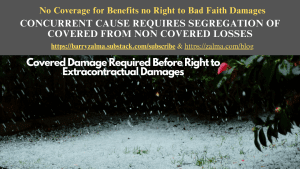No Coverage for Benefits no Right to Bad Faith Damages

Post 4707
See the full video at https://rumble.com/v4614d9-no-coverage-for-benefits-no-right-to-bad-faith-damages.html and at https://youtu.be/_1OWgl_l3P8
Landmark Partners, Inc. (Landmark) sued Western World Insurance (Insurance) after it denied Landmark’s claim under an insurance policy. Landmark asserted claims for breach of contract, statutory violations, breach of common-law duties, and attorney’s fees and statutory interest. Relying in part on the testimony of Landmark’s own expert, Insurance moved for summary judgment on the ground that the concurrent causation doctrine defeated Landmark’s contractual claim, which in turn defeated Landmark’s other claims. The trial court granted summary judgment for Insurance, and Landmark appealed.
In Landmark Partners, Inc. v. Western World Insurance, No. 02-23-00116-CV, Court of Appeals of Texas, Second District, Fort Worth (December 28, 2023) the Court of Appeals applied the concurrent cause doctrine to resolve the dispute.
BACKGROUND
Landmark’s policy with Insurance covered damage to Landmark’s commercial property, but only for damage that commenced during the policy period, which began on February 4, 2020. The policy included coverage for hail and wind damage but no coverage for rain damage to the property’s interior unless the rain entered the building through damage caused by a covered event. After a storm on May 7, 2020, Landmark filed a claim with Insurance, requesting that Insurance provide coverage for damage to Landmark’s building, which Landmark alleged had been caused by the storm.
Insurance sent a contract field adjuster to inspect the property. That adjuster reported no signs of hail damage on the property’s roofing materials. Landmark hired a public adjuster who disagreed and put in proof for more than one million. Insurance then retained an engineer, Jarrod Burns, who did find some hail damage, particularly to some mechanical units on the roof, but he determined that the damage had been caused before the policy took effect. Insurance denied the claim.
Landmark sued Insurance for failing to provide coverage.
Insurance filed a motion for summary judgment based on the concurrent causation doctrine, which applies “when covered and excluded events combine to cause an insured’s loss.” If both covered and uncovered events combine to cause a loss, and the covered and uncovered events are inseparable, then causation is concurrent, the insurance policy’s exclusion applies, and the insurer owes no coverage for the loss.
Covered damage to the property could not be segregated from non-covered damage. The trial court signed a final judgment granting summary judgment for Insurance. Landmark appealed.
DISCUSSION
Because an insurer has no obligation to pay for damage caused by an event not covered under the policy, if covered and non-covered events combine to cause the damage, the insured must segregate between the damage attributable to the covered event and the damage attributable to other causes. Thus, Landmark would have to show at trial one of three circumstances:
that the damage had only one cause, which was covered by the policy;
that the damage had multiple independent causes, one of which was covered; or
although covered and non-covered events combined to cause the damage, Landmark had segregated between the covered damage and non-covered damage.
Landmark had the burden to show that the damage for which it sought coverage resulted from the May 2020 storm or another covered event. If Insurance’s summary judgment evidence established as a matter of law that segregation was impossible, Insurance was entitled to judgment unless Landmark responded with evidence raising a fact issue.
Because Insurance’s summary judgment evidence established that any damage caused by the May 2020 storm could not be segregated from the damage caused by previous storms that were not covered, Insurance demonstrated that it had no obligation to pay under the policy, thereby negating Landmark’s breach-of-contract claim.
Landmark failed to segregate between covered and non-covered damage or even raise the possibility that segregation could be done. Even under Landmark’s evidence, the covered and non-covered causes of property damage could not be separated.
Because Landmark’s evidence did not raise a fact issue sufficient to defeat summary judgment on Landmark’s contract claim, the Court of Appeal found no breach of contract.
EXTRACONTRACTUAL CLAIMS
In addition to its contract claim, Landmark alleged violations of Texas Insurance and breach of the common law duty of good faith and fair dealing in the context of processing and payment of insurance claims.
The Texas Supreme Court has explained, an insured cannot recover any damages based on an insurer’s statutory violation unless the insured establishes a right to receive benefits under the policy or an injury independent of a right to benefits.
As for Landmark’s common-law bad-faith claim, that, too, was negated by the summary judgment evidence.
Having overruled Landmark’s five issues, the Court of Appeals affirmed the trial court’s judgment.
Without a right to the benefits of a policy of insurance there can be no right to bad faith tort damages. Landmark failed to establish a right to the benefits of the contract of insurance because it could not segregate covered damages from damages that preceded the policy. No coverage no right to claim bad faith damages for improper claims handling.
 (c) 2024 Barry Zalma & ClaimSchool, Inc.
(c) 2024 Barry Zalma & ClaimSchool, Inc.
Please tell your friends and colleagues about this blog and the videos and let them subscribe to the blog and the videos.
Subscribe to my substack at https://barryzalma.substack.com/publish/post/107007808
Go to Newsbreak.com https://www.newsbreak.com/@c/1653419?s=01
Go to X @bzalma; Go to the podcast Zalma On Insurance at https://podcasters.spotify.com/pod/show/barry-zalma/support; Go to Barry Zalma videos at Rumble.com at https://rumble.com/c/c-262921; Go to Barry Zalma on YouTube- https://www.youtube.com/channel/UCysiZklEtxZsSF9DfC0Expg; Go to the Insurance Claims Library – http://zalma.com/blog/insurance-claims-library.
Like this:
Loading…



